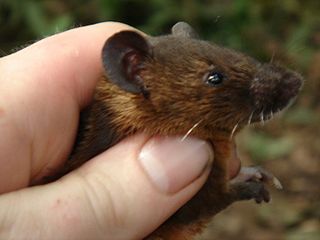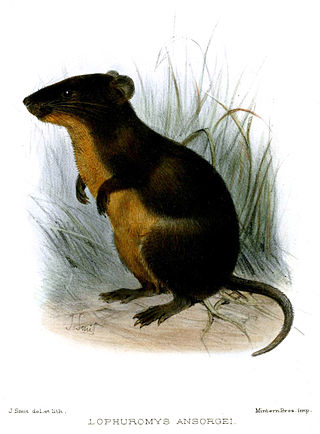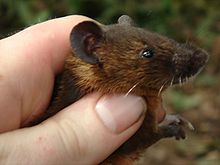
The subfamily Deomyinae consists of four genera of mouse-like rodents that were previously placed in the subfamilies Murinae and Dendromurinae. They are sometimes called the Acomyinae, particularly in references that antedate the discovery that the link rat, Deomys ferugineus, is part of the clade. Deomyinae is the older name and therefore has priority over Acomyinae.

Lemniscomys, sometimes known as striped grass mice or zebra mice, is a genus of murine rodents from Africa. Most species are from Sub-Saharan Africa; L. barbarus is the only one found north of the Sahara. They are generally found in grassy habitats, but where several species overlap in distribution there is a level of habitat differentiation between them.

The rusty-bellied brush-furred rat is a species of rodent in the family Muridae. It is found in Angola, Benin, Cameroon, Central African Republic, Republic of the Congo, Democratic Republic of the Congo, Ivory Coast, Equatorial Guinea, Gabon, Ghana, Guinea, Kenya, Liberia, Nigeria, Sierra Leone, Tanzania, Togo, and Uganda. Its natural habitats are subtropical or tropical moist lowland forests, subtropical or tropical seasonally wet or flooded lowland grassland, arable land, and pastureland.

Rhabdomys dilectus, the mesic four-striped grass rat, is a species of rodent in the family Muridae.
Crawford-Cabral's shaggy rat or Crawford-Cabral's shaggy marsh rat is a species of shaggy marsh rat endemic to north-eastern Namibia, near the Okavango River.
The Rwandan shaggy rat is a species of shaggy marsh rat endemic to north-western Rwanda, close to the Virunga Mountains.
The Tanzanian shaggy rat is a species of shaggy marsh rat endemic to eastern Tanzania, near the Uluguru Mountains.

Ansorge's brush-furred rat is a species of rodent in the family Muridae. It was identified in 1896 by de Winton as L. ansorgei. However, it was widely regarded as L. sicapusi until 2000, when Walter Verheyen, Theo Dierckx, and Jan Hulselmans published a study to the Bulletin of the Royal Belgian Institute of Natural Sciences describing it as a distinct species.
Thomas's Ethiopian brush-furred rat, also called the brown brush-furred rat or the brown brush-furred mouse, is a species of brush-furred mouse from Southern Ethiopia.
Dudu's brush-furred rat is a rodent belonging to the genus Lophuromys. It is native to the northeast of the Democratic Republic of Congo, from Kisangani to the eastern mountains of Garamba, Blukwa and Djugu to Irangi.
Verhagen's brush-furred rat is a rodent belonging to the genus Lophuromys. It is found between 2600 and 3050 m on Mount Meru in Tanzania. The species is named after Ronald Verhegen for his contributions to the ecology of small mammals of Tanzania.
Praomyini is a tribe of muroid rodents in the subfamily Murinae. Species in this tribe are found mostly throughout Sub-Saharan Africa, but one species is found in North Africa, and another is found in the Arabian Peninsula.
Stanley's brush-furred rat is a species of brush-furred mouse found in Uganda and the Democratic Republic of Congo.
Sabuni's brush-furred rat is a species of rodent in the family Muridae. It has been recorded from Tanzania.
Makundi's brush-furred rat is a species of rodent in the family Muridae. It is found in Tanzania.
Machandu's brush furred rat is a species of rodent in the family Muridae. It has been recorded from the Tanzania, Zambia, Malawi, and Mozambique.
Kilonzo's brush furred rat is a species of rodent in the family Muridae. It has been recorded from Tanzania.
The Sheko Forest brush-furred rat is a species of brush-furred mouse found in Ethiopia.
The North Western Rift brush-furred rat is a species of brush-furred mouse found in Ethiopia.
The Mount Chercher brush-furred rat is a species of brush-furred mouse found in Ethiopia.





